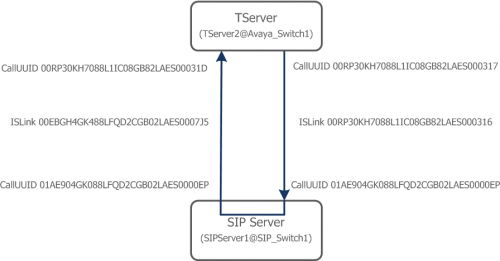Events and Model Reference
In addition to capturing the call recording media, recording servers also receive call events from Genesys SIP Server or T-Servers. The Genesys Events and Models Reference provides a detailed guide on capturing events related to a call or agent events.
There are a few important notes related to multi-site call scenarios to clarify how to reference all call events related to the customer interaction across multiple T-Server instances.
- The CallUUID is a unique call identifier generated on each T-Server instance (or SIP Server instance). When a call is transferred from one T-Server to another, a new CallUUID is generated on the other T-Server.
- The ConnID is an identifier assigned to reference a call to initiate requests. In some cases, the ConnID is maintained across multi-site transfers. However, the ConnID is not guaranteed to be unique across multi-site transfers in some cases.
Genesys offers a mechanism called Inter-Site Link (IS-Link) to build a linked list of call identifiers for the customer interaction across multiple sites. The following is a short overview of how the mechanics work; for full details please refer to the "Multi-Site Call Scenarios" section in the Genesys Events and Models Reference.
When a multi-site call transfer is initiated, it is important to look for the AttributeISLinkList attribute provided by the EventCallDataChanged event on both of the T-Servers. In order to get call-based events, use the RequestStartCallMonitoring event to register for call-based events. When the call is being transferred out of a T-Server, the EventCallDataChanged event provides an additional attribute called AttributeISLinkList. This is a globally unique identifier that is linked to the destination T-Server. Use this ISLink identifier to locate the CallUUID associated with each T-Server instance, so that the entire call can be traced through all transfers across switches.
The AttributeISLinkList attribute provides two more keys:
- location-name—The switch name of the remote T-Server.
- direction-role—Either source or target. If set to source, this T-Server is initiating the transfer. If set to target, this T-Server is receiving the transfer.
ISLink
An example of a call transfer that results in a change of ConnID on T-Server. The ISLink can provide a way to link the CallUUID between different switches.
The call is initially on Tserver2, and transfers the call to SIPServer1.
The EventCallDataChanged event on Tserver2:
@09:41:00.5404 [0] 8.1.001.05 distribute call/party event: message EventCallDataChanged
AttributeEventSequenceNumber 0000000000057726
AttributeTimeStamp 508e957c00083f40
AttributeConnID 009a021843038407
AttributeCallUUID ‘00RP30KH7088L1IC08GB82LAES000317’
AttributeFirstTransferConnID 009a021843038407
AttributeLastTransferConnID 009a021843038407
AttributeISLinkList [108] 00 01 03 00..
‘00RP30KH7088L1IC08GB82LAES000316’(list) ‘location-name’ ‘SIPServer1@SIP_Switch1’
‘direction-role’ ‘source’
When the call is received on SIPServer1, the EventCallDataChanged shows a common ISLink. This event provides the CallUUID and ConnID for this call on SIPServer1. Note that the ConnID event is common between the two T-Servers at this point.
@10:41:00.4955 [0] 8.1.001.03 distribute call/party event: message EventCallDataChanged
AttributeEventSequenceNumber 000000000002d478
AttributeTimeStamp 508e957c00078fc6
AttributeConnID 009a021843038407
AttributeCallUUID ‘01AE904GK088LFQD2CGB02LAES0000EP’
AttributeISLinkList [108] 00 01 03 00..
‘00RP30KH7088L1IC08GB82LAES000316’(list) ‘location-name’ ‘Tserver2@Avaya_Switch1’
‘direction-role’ ‘target’
SIPServer1 then transfers the call back to Tserver2. The EventCallDataChanged event shows the ISLink list as the second item in the list.
@10:41:03.5465 [0] 8.1.001.03 distribute call/party event: message EventCallDataChanged
AttributeEventSequenceNumber 000000000002d4c3
AttributeTimeStamp 508e957f000856fe
AttributeConnID 009a021843038407
AttributeCallUUID ‘01AE904GK088LFQD2CGB02LAES0000EP’
AttributeISLinkList [214] 00 02 03 00..
‘00RP30KH7088L1IC08GB82LAES000316’(list) ‘location-name’ ‘Tserver2@Avaya_Switch1’
‘direction-role’ ‘target’
‘00EBGH4GK488LFQD2CGB02LAES0007J5’(list) ‘location-name’ ‘Tserver2@Avaya_Switch1’
‘direction-role’ ‘source’
Tserver2 now receives the EventCallDataChanged evemt with the ISLink. Note that a new CallUUID and ConnID is assigned for this call.
@09:41:02.9674 [0] 8.1.001.05 distribute call/party event: message EventCallDataChanged
AttributeEventSequenceNumber 000000000005775c
AttributeTimeStamp 508e957e000ec324
AttributeConnID 009a021843038407
AttributeCallUUID ‘00RP30KH7088L1IC08GB82LAES00031D’
AttributeISLinkList [108] 00 01 03 00..
‘00EBGH4GK488LFQD2CGB02LAES0007J5’(list) ‘location-name’ ‘SIPServer1@SIP_Switch1’
‘direction-role’ ‘target’

